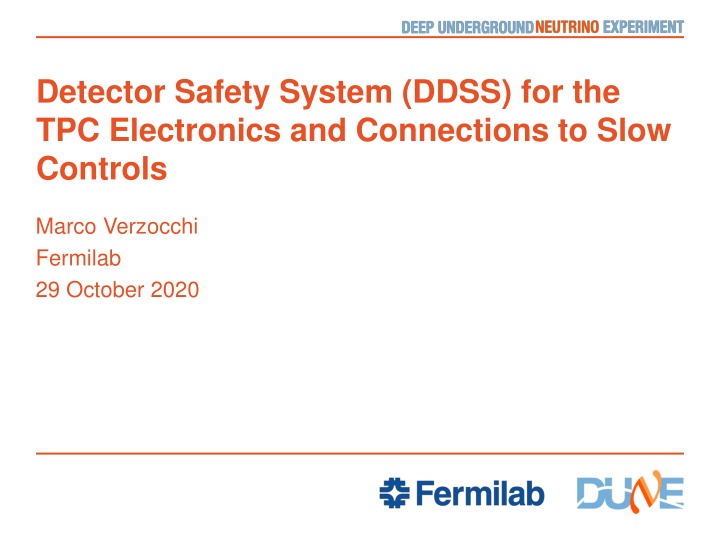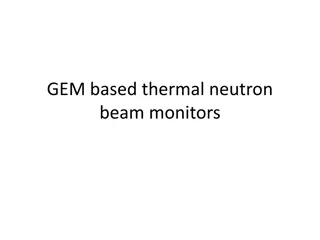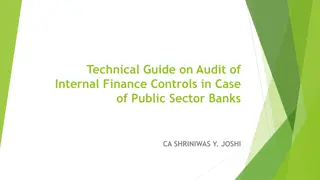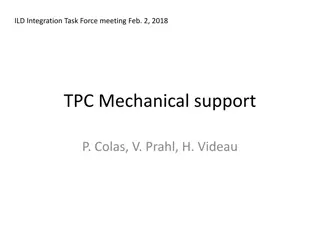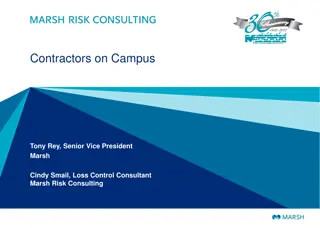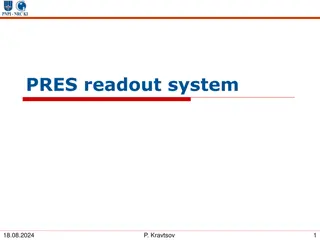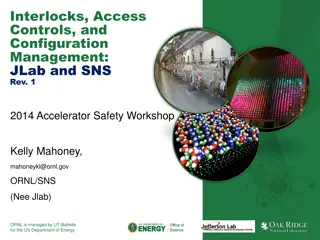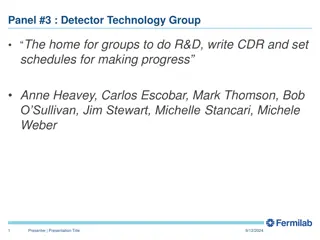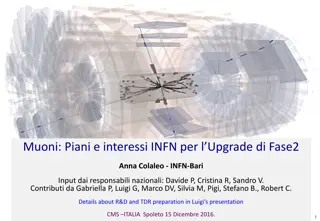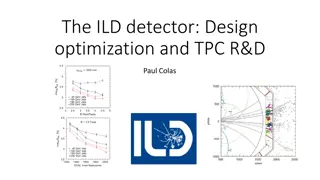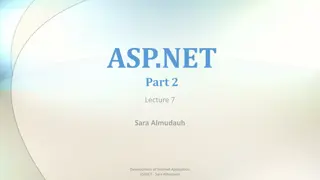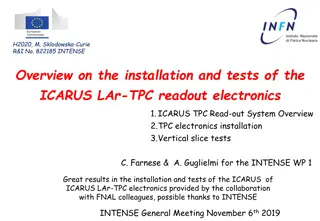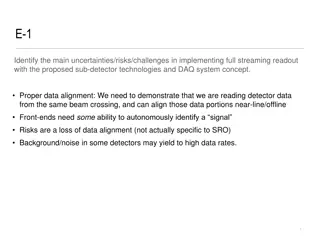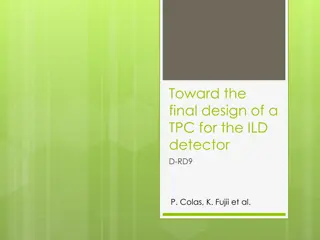Detector Safety System (DDSS) for TPC Electronics and Connections to Slow Controls
The Detector Safety System (DDSS) for TPC Electronics involves multiple protection levels including slow controls, PLC-based systems, and fuses/diodes to ensure detector safety. It's crucial to consider these aspects during the design phase as modifications post-design are challenging. The system, designed by Marco Verzocchi at Fermilab, emphasizes fast response times and the need for a proactive approach to safety measures.
Download Presentation

Please find below an Image/Link to download the presentation.
The content on the website is provided AS IS for your information and personal use only. It may not be sold, licensed, or shared on other websites without obtaining consent from the author.If you encounter any issues during the download, it is possible that the publisher has removed the file from their server.
You are allowed to download the files provided on this website for personal or commercial use, subject to the condition that they are used lawfully. All files are the property of their respective owners.
The content on the website is provided AS IS for your information and personal use only. It may not be sold, licensed, or shared on other websites without obtaining consent from the author.
E N D
Presentation Transcript
Detector Safety System (DDSS) for the TPC Electronics and Connections to Slow Controls Marco Verzocchi Fermilab 29 October 2020
History& References (i) TPC Electronics has been working with Terry, Linda, Trevor, and Ian on concept for DDSS since February Links to meetings - Revisit ICEBERG, goals for DUNE (14 February) - Comparison of different options, desire for PLC system (5 May) - TPC electronics view of PLC system (14 May) - Project controls engineer initial ideas on PLC system (22 May) - Progress toward design (28 May) - Expanding to other systems (4 June) - Rack space needs, network connections (11 June) - How to describe the system / action matrix (2 July) 29 Oct 2020 M. Verzocchi |DDSS and SC for TPC Electronics 2
History & References (ii) TPC Electronics has been working with Terry, Linda, Trevor, and Ian on concept for DDSS since February Links to meetings - DDSS design (low voltage supplies, interface to PTC) (23 July) - DDSS design (bias voltage supplies, available in EDMS) - Action matrix in plain English language (10 September) - Starting to write documentation of action matrix, ideas on interface with slow controls (22 October) Summary presentation given at the technical board meeting of 1 October - Includes motivation, design, action matrix - Rest of this presentation includes brief summary of TB presentation with additions from 10/22 meeting 29 Oct 2020 M. Verzocchi |DDSS and SC for TPC Electronics 3
Interlocks Detector safety can be achieved through multiple level of protections Detector safety needs to be taken into account during the design phase - Hard to make additions to a complete detector design Multiple level of protection - One end: Slow controls Identify trends, issue warning or alarms, response time O(1-10 s) We really don t know how well the slow control system scales with the number of components - SC system is active only if all the software on all nodes is operating - - Middle: PLC based system (fast response, independent from SC, some programmability) - Opposite end: fuses, diodes Very fast response, but in case of problems may need to replace components before resuming data taking Once you ve designed the system, you cannot modify the protection, unless you redesign components - 29 Oct 2020 M. Verzocchi |DDSS and SC for TPC Electronics 4
How the design was developed 1. Identify the risks - Electrical and thermal dangers - May also have to consider instabilities in the cryogenic system 2. Decision on architecture - Protections Slow controls, identify trends, set warning and alarm levels PLC system to ensure that protections are always present, even when the slow control system is not operating Low level hardware protection (fuses) 3. Granularity Prefer a system where we have interlocks at the APA level, avoid turning off multiple APAs in case of problems clearly identified with a single APA - 29 Oct 2020 M. Verzocchi |DDSS and SC for TPC Electronics 5
How is the system built ? (i) System architecture - Controller Beckhoff CX5120 PLC - Groups of I/O modules distributed across racks needing interlocks - Fieldbus organized in a loop topology, daisy-chained from rack to rack - Need two types of racks Low voltage power supplies (repeat 25 times, one per row of APAs) Bias voltage supplies (repeat 5 times, one every 5 rows of APAs) 29 Oct 2020 M. Verzocchi |DDSS and SC for TPC Electronics 6
How is the system built ? (ii) PLC Rack - One Rack (location TBD) - Programmable Logic Controller (PLC) Contains all logic for DDSS Communicates with slow controls Temperature / humidity / dewpoint transmitter Dewpoint factors into flange heater logic controller Beckhoff CX5120 PLC 29 Oct 2020 M. Verzocchi |DDSS and SC for TPC Electronics 7
How is the system built ? (iii) TPC low voltage racks - 25 Racks (6 flanges per rack, 150 flanges total) - Fans (4 per flange) 24V discrete output to power fan 24V discrete input reads fan run status - Heaters (4 per flange) 24V discrete output to power heater - RTDs (temperature sensors) (2 per flange) RTD input to read temperatures - Wiener PL506 interlocks (1 per flange) 5V discrete output to single channel interlock - Power & Timing Control (PTC) (1 per flange) EtherCAT communication over fiber optic cableController 29 Oct 2020 M. Verzocchi |DDSS and SC for TPC Electronics 8
How is the system built ? (iv) Bias voltage racks - 5 Racks ISEG Module Interlock Relay for single channel inhibit (interlock) - 658 channels total 450 bias voltage and 208 field cage Channels per rack varies rack-to-rack (average is 132) DDSS designed to support up to 9 ISEG modules (144 channels) 29 Oct 2020 M. Verzocchi |DDSS and SC for TPC Electronics 9
Action Matrix (i) 1. Power and monitor the fans on the WIECs If the fans do not provide sufficient cooling for the WIEC, turn off the bias voltage on the corresponding APA, then turn off the WIEC - Monitoring information to the Slow Controls: fans status (600 bits) Receive from Slow Control GUI: enable/disable power to fans 2. Power the heaters on the CE flange Monitor the temperature on the flange, compare it with the dew point in the cavern (humidity measurement from central PLC), and decide how much power should be provided to the heaters; if the temperature is too close to the dew point, turn off the bias voltage on the corresponding APA, then turn off the WIEC - Monitoring information to the Slow Controls: heaters status (300 bits), 300 temperature measurements, 1-2 humidity measurements Receive from Slow Control GUI: enable/disable power to heaters 29 Oct 2020 M. Verzocchi |DDSS and SC for TPC Electronics 10
Action Matrix (ii) 3. Enable/disable low voltage power supply channels In addition to reasons listed on the previous slide, could decide to turn off the LV supply in case of cryogenic problems, HV discharges, other global vetoes on powering the detector Monitoring information to the Slow Controls: interlock status (150 bits) Slow Control responsible for turning on/off low voltage power 4. Enable/disable bias voltage supply channels In addition to reasons listed on the previous slide, could decide to turn off the LV supply if the FEMBs are not powered on, in case of cryogenic problems, HV discharges, other global vetoes on powering the detector FEMB information sent to PLC via PTC interface, monitoring information on FEMB status sent from WIB/PTC to SC, it is worthwhile monitoring the interlock status from the FEMBs at the PLC (750 bits) Monitoring information to the Slow Controls: interlock status (658 bits) Slow Control responsible for turning on/off bias voltages - - 29 Oct 2020 M. Verzocchi |DDSS and SC for TPC Electronics 11
Interface with Slow Controls Slow control system may not be able to perform certain operations because there is an inhibit signal coming from the DDSS Slow control system needs to get list of current inhibits from the central PLC via Ethernet (central PLC will be an OPC UA endpoint) It would be preferable to have a single GUI for DDSS and SC Following slides are from the 22 October meeting and discuss ideas for how DDSS/SC communicate / share control of devices 29 Oct 2020 M. Verzocchi |DDSS and SC for TPC Electronics 12
Low Voltage Supplies WIENER PL506 (6 channels, 1 per APA), 25 modules - All settings are controlled from Slow Controls Non expert menu allows users to turn on/off individual channel All other settings (ramp speed, voltage settings, thresholds for warnings/alarms, action to be taken in case of interlock failures) are restricted to expert users Monitored by slow controls - Receive interlock signal from DDSS Assume that monitoring information for interlock signal is sent from DDSS to slow control via the main PLC computer Not sure this can also be monitored from the PL506 as well 22 Oct 2020 M. Verzocchi | Slow Controls vs DDSS 13
Bias Voltage Power Supplies WIENER MPOD (5 crates) with 45 ISEG modules total - All settings are controlled from Slow Controls Non expert menu allows users to turn on/off individual channel All other settings (ramp speed, voltage settings, thresholds for warnings/alarms, action to be taken in case of interlock failures) are restricted to expert users Monitored by slow controls - Receive interlock signal from DDSS Assume that monitoring information for interlock signal is sent from DDSS to slow control via the main PLC computer Not sure this can also be monitored from the MPOD as well 22 Oct 2020 M. Verzocchi | Slow Controls vs DDSS 14
WIB / PTC The WIBs are entirely under the control of Slow Controls and DAQ The WIB can receive interlock signals (via the PTC) from the DDSS, assume that these are monitored from DDSS, but could also be monitored via the WIB-SC connection The WIB sends information used to build interlock signals (via the PTC) to the DDSS. Assume that the detailed monitoring of currents, voltage, temperature on the WIB (and status of the FEMBs) is sent directly from the WIBs to SC. Assume that the DDSS will send only monitoring information at the level WIB xxxx is interlocked The same applies also for the PTC 22 Oct 2020 M. Verzocchi | Slow Controls vs DDSS 15
OPC UA Endpoint OPC UA is the protocol used for Slow Controls - Endpoint is software block that runs somewhere that controls the hardware - Each WIENER MPOD (*5) and each WIENER PL506 (*25) is a OPC UA endpoint It is not yet clear to me whether - We deploy 900 OPC UA endpoints (1 per WIB/PTC) on the Zynq CPUs inside the FPGAs on the WIBs/PTC - We deploy fewer OPC UA endpoints (1 per row of APAs ?, only 1 per far detector module) in the computer(s) that run the slow controls program(s) for the TPC electronics - This is an architecture decision for the DAQ/SC group - Need input from the DAQ/SC group 22 Oct 2020 M. Verzocchi | Slow Controls vs DDSS 16
Temperature & humidity sensors We have 4 RTDs on each of the 150 flanges, only 2 of them are actually connected to the readout modules (Beckhoff EL3202- 0010) - Information from the RTDs is used in the PLC logic to decide whether to turn on/off the heaters We have 2 dedicated humidity sensors on the top of the cryostat that are read out through the Beckhoff EL3052 connected on the central PLC panel - Information from the humidity sensors is used in the PLC logic to decide whether to turn on/off the heaters This information should also be transferred from the PLC to slow controls for monitoring 22 Oct 2020 M. Verzocchi | Slow Controls vs DDSS 17
Status of heaters/fans (i) Each flange has 4 heaters / fans Slow control should have an overall flange on/off command - Sent from SC via PLC computer - Turns off all heaters and fans for that flange, which then generates interlock signal for low voltage and bias voltage supplies This is essentially a switch off the flange command - Enable power to heaters and fans, at which point DDSS takes over their operation and the generation of interlock signals for the low voltage and bias voltage supplies 22 Oct 2020 M. Verzocchi | Slow Controls vs DDSS 18
Status of heaters/fans (ii) Information available for each heater - Power: ON/OFF (decided by the PLC) Information available for each fan - Power: ON/OFF (decided by the PLC) - Spinning: ON/OFF (PLC readout via Beckhoff EL3202-0010) This information should be sent from the PLC to Slow Controls It is not clear that we want to allow SC to turn on/off individual heaters / fans - This should be an expert action, may require logging into the DDSS GUI 22 Oct 2020 M. Verzocchi | Slow Controls vs DDSS 19
Conclusion It would be preferable to present all the slow control information in a single GUI, independent of whether this come directly from the OPC UA endpoint on the detector (WIENER MPOD and PL506, WIBs, PTCs) or whether it comes through the DDSS/Slow Control interface (OPC UA endpoint on the central PLC) - This should also integrate the display of the status of interlocks (and possibly expert level interface to enable / disable interlocks ?) Full access to PLC should be via separate GUI 22 Oct 2020 M. Verzocchi | Slow Controls vs DDSS 20
